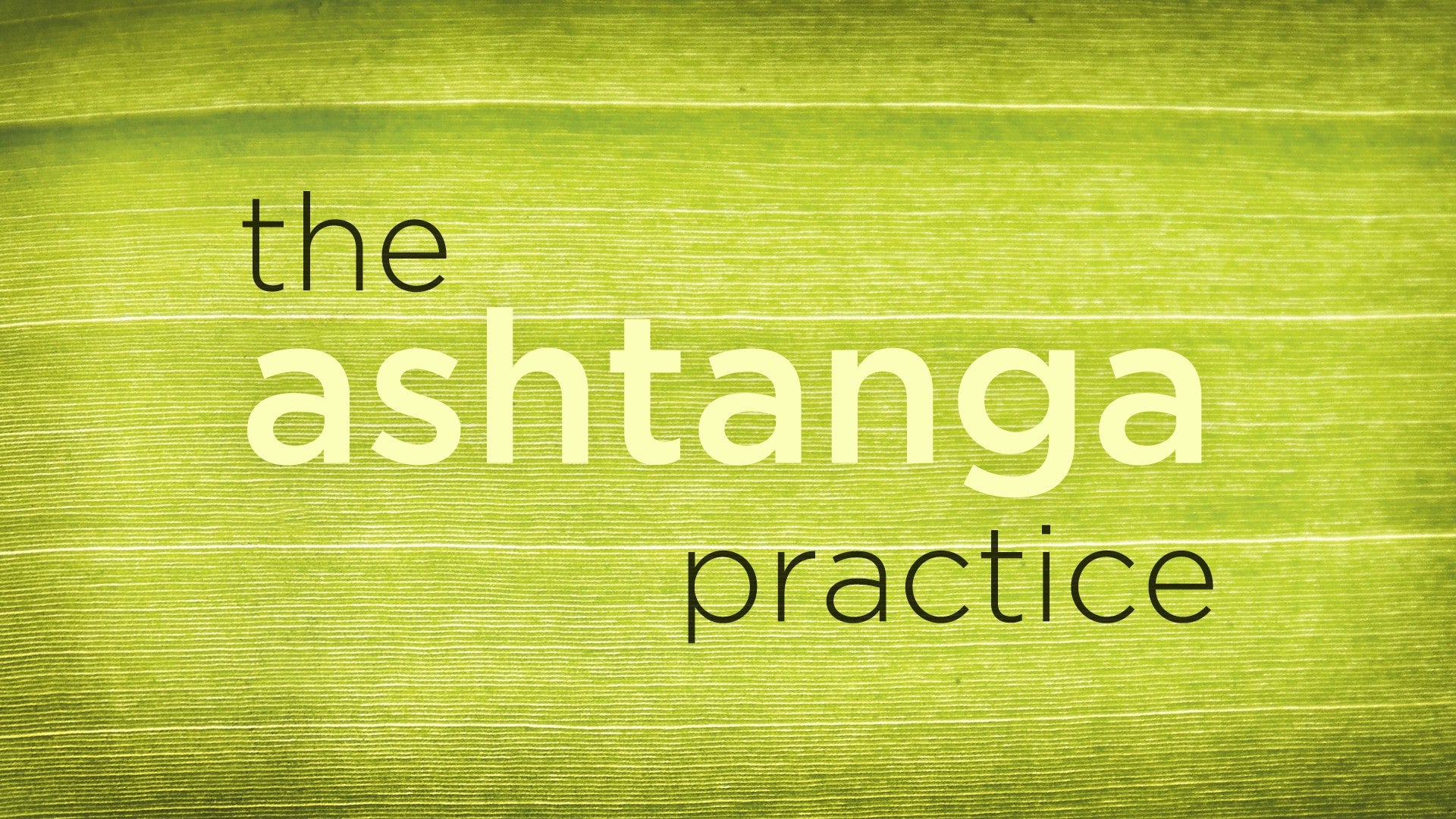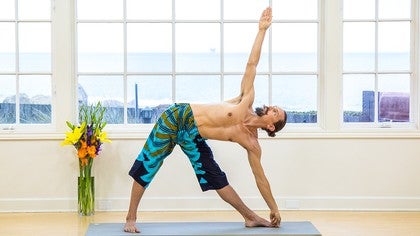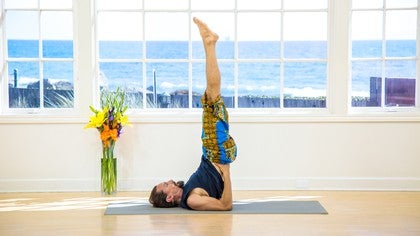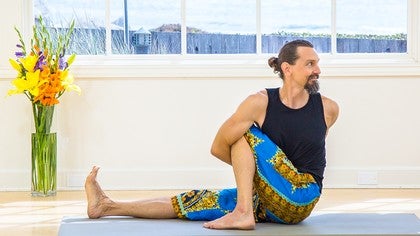Description
About This Video
Transcript
Read Full Transcript
Salutations and great gratitude for investing this time to really deeply explore how yoga might work for you. We know that yoga gives this light on an internal awareness, but also one key factor and benefit and technique is to avoid that very natural human tendency to rush for something outside, to grab or to try to go as fast as you can, to try to acquire some postures or yoga. So for me I find the real cornerstone of a practice is restraint, is staying off of your maximum instead of trying to get as much yoga as you can, finding a comfortable middle zone where you're absolutely in your spot and you can practice with the awareness instead of rushing to get to the next thing. Now ashtanga offers a really great physical technique that is a metaphor for this restraint. We use physical restraint during our entire ashtanga practice and we see that showing up through mula bandha and udiyana bandha.
So these are the, bandha means lock and these are the central energetic locks that are key to our practice. You can easily find udiyana and probably even mula bandha by just exhaling out extra breath. So from a natural standing position or seated if you like, take a full deep inhale and then exhale completely pushing out extra breath, noticing which muscles are recruited and trying to really pause there after the breath, drawing the belly in and then lengthening the spine still not breathing, keeping the belly drawn in and keeping the muscles recruited slowly inhale, seeing if you can feel that there's still that internal lift that the abdomen stays restrained. Let's do one together and you can watch me if you're not sure what we're talking about. So with that technique of physically restraining the lower abdomen and pelvic floor even, you will find that you're able to keep the breath more measured and you're more easily able to follow the exact vinyasa count which will be restrained in itself instead of just trying to flip through the poses as quick as possible.
Enjoy the ride when you're moving from one posture to the next. All right, so let's take a look at some of these fundamental asanas. Come to standing at the top of your mat and samastitihi. Take a full exhale, again finding of course that the abdomen is drawn in. Now you've finished sun salutation A and B in your regular daily practice here.
So we'll go into fundamental asanas, inhale, step or jump your feet of hips distance apart. Your hands might even cue ryanabhanda in. Take an extra exhale as you fold forward, drawing the belly up to the spine and take two fingers wrapping around each toe, each big toe that is. The name of the pose, parangusthasana, Ekam, the first breath. Still keeping the belly drawing in, inhale, lengthen the spine, lengthen the arms, even straighten the arms, straighten the spine and pull the chest absolutely forward with straight arms looking forward.
And then do an exhale, keeping that length of the spine, bend the elbows and let the chest draw in towards the thighs. Now if you need to bend the knees, of course you're welcome to bend the knees here. If you can do it comfortably with straight legs, allow a little weight to lean forward towards the front of the feet so root knuckles are grounding. Don't just rest on your haunches, instead lean weight forward if you're comfortable with straight legs. And avoid letting the elbows come too far out to the side or all the way back, but have them in a middle place in between side and back.
Dropping the head, take deep full breaths, feeling the belly, draw away from the thighs, moving the belly to the spine, take another full inhale, and exhale completely pushing extra breath out, again trying to find that scooping of udiyana bandha, and trainee inhale, let the spine lengthen, keep the belly strong and drawn in, looking forward, the head comes up with a long spine, and then the next posture, exhale, put your hands under your feet and step the toes all the way to the wrists there, the root knuckle of big toe, and the root knuckle of index mound connecting, root to root. Parahastasana, ache and inhale, lengthening the spine, lengthening the arms, looking forward, you might need to bend the knees, that's fine, try to find length through the spine. And do an exhale, folding forward, letting the top of the head drop down towards the mat, one, looking towards your nose, keeping long, full deep breaths possible, again if you're comfortable with straight legs, you could straighten them, making sure you're not on your haunches, but leaning weight forward towards the fronts of the feet, it may even feel like you're moving forward into a risky position, and that's good, use that risk to enliven and awaken your practice, keeping mula bandha, the pelvic floor lifted, and udiyana bandha of course, belly away from thigh. Take another full inhale, exhale completely here, scooping the belly in, and trini, inhale and follow that breath forward, straight arms, straight spine, head up, exhale here, and you can find your way, perhaps with knees bent, back to the standing position of samastitihi, however you like. And now moving to uttita trigonasana, I can inhale, and as you inhale, step your right foot, your right foot towards the back of the mat, keep your heels in a line, and really see that you've found an efficient step, your heels are in a line parallel to the long edge of the mat, if you need to adjust them, adjust them for now, but as you practice, keep refining it, so eventually your step will become just one breath there.
And then pivoting on your right heel, so without changing the distance between the heels, pivot on your right heel, and draw the right toes to face the back of your room, you can raise the arms up with collarbones broad, and do an exhale reaching out over the right foot, keeping the right side of the body nice and long, maybe the hand just hangs down there, or maybe you're able to reach in deep enough that you again grab the big toe, and then let your eyes journey upwards, one towards the lifted left thumb, still long, fully breathing, finding every exhale, drawing the abdomen in. Notice if you have a tendency to start dropping or dumping, and try to stay rising up, seeing if you can get the hand, if you're just resting here, to not put weight down, and if you're taking the big toe, make sure that the hand stays off of the foot, and that you don't drop weight through the right foot. Exhale completely here, and then 3D, inhale, come up. Now pivoting just upon the heels again, so the distance between the step doesn't change, nor does the width of the step, Chaturri, exhale, reach out over your left foot, again, it may just be that the hand comes down, not pushing weight down, but just resting gently, you gaze towards the right thumb, or maybe that you're able to keep the hips in integrity and still take the big toe. Every exhale, drawing the abdomen in, and trying to also see that the thumb stays just above the shoulder, so in this case your right thumb just above the right shoulder, avoid the temptation, let the arm flap back, instead just keep it all lifted, even as you keep the left kneecap lifting, left thigh really strong, take a nice full inhale, exhale completely, and punch it, inhale, and ride that inhale all the way back up.
Now breathe freely as we explore how we're going to change the feet here, you've come back to your neutral and expanded position, Parivrttatrikonasana, the twisting triangle, we'll want to keep the same distance between the heels, and want to keep the same width between the heels as well, so for me I pivot on my root knuckle, I step my right heel back a little, and then to get the back foot in position I pivot on the root knuckle and step the left heel back a little, so now I've got heels in a line, it's fine if they need to be wider for now, and I've got the same distance because I step both heels back a bit, anyway you work out what it's going to be, just try not to change your distance or your width too much. Now the temptation in this posture in Parivrttatrikonasana is to use momentum, to try to slingshot your arm down and get as deep as you can the pose, of course I want you to work with restraint, so try to control your descent, square the hips to the back of the room, and don't even worry about bringing the arm up for now, instead let's have your hands just cue your hips, making sure that the right hips drawing back so hips stay square, take a full inhale here and we'll jump back into the count, good, and do an exhale folding forward, just like a forward fold, the right hip draws back, the shoulders stay parallel to the mat, and drop your left hand down, maybe it can be on a block or come onto the foot or inside the foot, if you can get it down all the way outside the foot, great, and then still breathing, draw your right shoulder above the left, so the shoulders become stacked, raise the right arm up, and breathe, gazing up towards the right thumb, again avoiding the temptation to flap the arm back, fool yourself thinking you're twisting deeply, instead just keep thumb above the right shoulder, right shoulder above the left, take one full inhale lengthening the head towards the front of the room, and then exhale and look down towards the big toe, trini inhale come up, conscious and mindful of your feet, maybe back to the neutral position, and then changing the side by pivoting on root knuckles, getting the hips square, inhale fully when you're ready, and then the Chaturwari count would be to fold forward like a forward fold, you can even reach the right hand forward, not up, but just straight forward, keeping that length through the right side of the body, and then dropping the hand wherever it's going to comfortably rest, inside or outside or on the prop, drawing the left shoulder above the right, and the left thumb just above the shoulder and breathe, make sure that every inhale your head moves towards the back or front of your room, and every exhale that your hips move in the opposite direction, so that you keep that length between the hips and the chest between the head and the hips, and then exhale look down, see your big toe, and pancha inhale rising up, now bring your feet parallel and your arms slightly out, so you've come back to the neutral position expansive, and with your exhale step back to the samastitihi at the top of the mat, a neutral position but that's more drawing in, parsvakonasana, ekiminhale take a really long step to the back of the room, so your right foot goes back, and then from there pivot on your feet, pivot on your right heel so it faces the back of the room, and do an exhale slowly descend, bend your right knee so that it comes all the way above the ankle, and it may be your right forearm down upon the right knee, that's a fine place to be with the left arm arching over and forward, see if you can restrain the drishti, the eyes onto the centre of the palm, or if you're comfortable in the pose you may be able to bring the right hand down outside, outside the right foot, with the right shoulder outside the knee, again drishti comfortably resting onto the centre of the left palm, every exhale drawing the abdomen in, every inhale keeping it locked, and then three knee inhale slowly up, keeping feet in the neutral position and then pivoting on the left heel and exhale, you can have the forearm down or hand down on the foot, gazing to the right palm, now try to see that the eyes are also restful and the space between the eyebrows is not bunching up or balling up, the tongue behind the upper teeth, the little smile on the lips, and every exhale drawing the abdomen in, punch your inhale come up, feet parallel in the neutral position, parivrta, the twisting of the parsvakonasana, exhaling, you can pivot on your right foot, so the right heel that is, the right foot faces the back room, and then bend the right knee deeply, still keeping that right hip drawing back with the knee really bent, try to get your left elbow over the knee or maybe the left shoulder or upper arm over the knee, now if that doesn't feel so comfortable, for now you might be in a modified position, and that's great, keep the right knee deeply, bending the right hip drawing back and feel the twisting action of the spine, of course if you are able to get the shoulder all the way locked over the knee, plant the hand down outside the foot, and then you can raise the right arm, arching over and forward just as in the previous posture, gazing comfortably gently at the palm, every exhale draws the belly away from the thigh, exhale look down, see the big toe, three knee inhale come up, pivot on your feet, change the side, and chatwari exhale go down, now the temptation is going to be to try to grasp towards the full posture, even when you're not ready, not flexible enough to get there, so instead of doing that, try to take the modifications, what I mean by grasping is that we sometimes see the person next to us or the teacher on the screen and think oh I can put my foot down, my hand down outside my foot, and then we wind up in here, now notice now my shoulder is not pressing on my knee, so now I've lost any kind of pushing to twist, which I might have gained through the modification, so only put your hand down if you can keep the shoulder all the way locked over, restrain yourself from grasping towards the deepest posture you possibly could, and instead enjoy the ride of daily practice as it brings you closer and closer to that internal awareness, exhale look down, punch your inhale and come up, expansive and exhale samastitihim, drawing in, prasarita parottanasana, step your right foot back, feet parallel, hands on the waist, do a exhale folding forward, put your hands down in between your feet, and again inhale, head up long spine, look forward, three knee exhale drop the top of the head, see that your hands are about a shoulder's width apart, and keep the elbows ever so slightly drawing in, one, if you're comfortable with straight legs you're leaning weight forward towards the front of the feet, really spreading the toes, so the middle toes lift off the mat, but the root knuckles, the big toe mounds are deeply grounding, exhale completely here, and again tatwadi, inhale, head up long spine looking forward and pause, exhale here, then the hands might take the hips and punch an inhale, ride that breath all the way up to the standing position, exhale here, prasarita b, that can inhale, feel the chest expand and lift, let the shoulders roll back and down and then lift the arms, you have plenty of time to do these postures, do a exhale, hands just return to the mat, keeping tailbone tucked and chin down, again inhale, and three knee exhale, fold all the way forward, keeping the fingertips on the hips and reaching in with the fingers, drop the head, one, so in between the fingertips you might feel that restraint of rudhyana bandha drawing the belly to the spine, try to keep the elbows slightly moving towards one another behind your spine, and again allow weight to lean forward towards the front of the feet if that's comfortable for you, exhale completely, and then tatwadi, inhale, come all the way back up, then exhale, prasarita padottanasana c, again inhale the arms out to the side, shoulders back and down, tailbone down, do a exhale, interlace the fingers behind you, again inhale, lengthening the arms, and three knee exhale, fold forward, dropping the head, and this time allowing the hands to come away from the hips, reaching the hands over so they might come back and down or even towards the mat, if it's really comfortable for you, you can be palms together, or if you need some space in the shoulders you may find that you've got the palms very separated with just the fingers locking, do try to use the fingertips to make sure that you're keeping the hands actively grabbing one another, exhale completely and tatwadi, inhale, rise all the way up, and exhale here, d, hands to the waist, akkam inhale, chest lifts, chin drops, do a exhale, fold forward, grab your big toes, first two fingers, again inhale, long spine, head up, look forward, and three knee exhale, drop the top of the head, now if you're not fully able to come with your head on the mat that's fine, you might for now have knees bent as well through all these postures of course, feel free to modify however it's right and just understand the daily practice will bring you deeper into the poses, no need to push or rush to get anywhere today, exhale completely and then tatwadi, inhale, head up, long spine, look forward, operating with restraint, just exhale here, udiyana bandha, pancha, inhale, come up, hands take the waist, and exhale, step back to your neutral samastitihi, parshvottanasana, so now we'll take on the last of the fundamental asanas, and it's said that the fundamental asanas contain the entire practice in a microcosmic kind of condensed form, so in that case parshvottanasana is the last of those postures, it's the tail end of the practice, it's sort of like the back bend of the fundamental asanas, so restraint will be really important here and you can really see it play out, it'll be a great challenge for your restraint, so from samastitihi then we'll break it down and take a few breaths, but ekam, inhale, take a small step to the right, bring your right toes to face towards the back of the room, and square the hips towards the back of the room, now ideally at the same time you would have put your hands back into a mudra with all the five fingers pressing into one another or pressing into the opposite on the other hand, and in that case the pinkies would be just up somewhere in the thoracic spine or in between the shoulder blades, and they'll be great because they'll keep an eye or they'll be able to feel, if at any point when you're going forward with a straight spine, the pinkies will feel if the spine buckles and if you start to bow and bend and crumple and collapse, and I would say don't worry about getting your head down low, instead try to keep the integrity, now this hand position might not be available to you today, no problem, in which case you reach back behind you, maybe take your elbows into the opposite hand, if that's not available simply grab the forearms or even towards the wrists as best you can with the opposite hand, and then exhale here, with your next inhale remember that the spine is long, the chest is lifted, the shoulders roll back and down, and from whatever hand position you're using, exhale folding forward, keeping the right hip back and operating with restraint, only go down as far as you can with a long straightened spine, looking onto the right big toe, anytime you feel like the spine might crumple or collapse, just raise yourself up, even if you don't come down deeply into position and try to straighten the spine, looking on the toe and breathing, every exhale draws the belly in, every exhale again lengthens the spine, so regardless of how deep you go, avoid the temptation to let the spine round, and just keep the drishti calm and on the right big toe, exhale completely, trini inhale come up, if you can keep the hands in the position, keep them there, pivot, change the side, the hips square to the front of the room, and then chatwari, exhale folding forward, looking onto the left big toe, notice that the other toes are spreading apart from the big toe, and be conscious of your back foot here as well, the right toe is really spreading, even as the spine stays straight and long, really testing your restraint, instead of grasping or rushing into the posture, trying to keep yourself suspended with integrity throughout the spine, exhale completely, and pancha, inhale come up, your feet become parallel, arms out, and exhale, back to samastitihi, that neutral pose of standing. So we've explored the fundamental asanas seen through the lens of restraint, and interestingly that lens of restraint, it doesn't keep you locked up or imprisoned, but you'll realize once you stop trying to grasp the next thing, you can really enjoy the freedom and the delight that's in this very present moment. So take that time, enjoy your practice, savor each and every breath, and I hope that you keep practicing, and I hope this has been useful, thank you.
The Ashtanga Practice: Dylan Bernstein
Comments
You need to be a subscriber to post a comment.
Please Log In or Create an Account to start your free trial.













